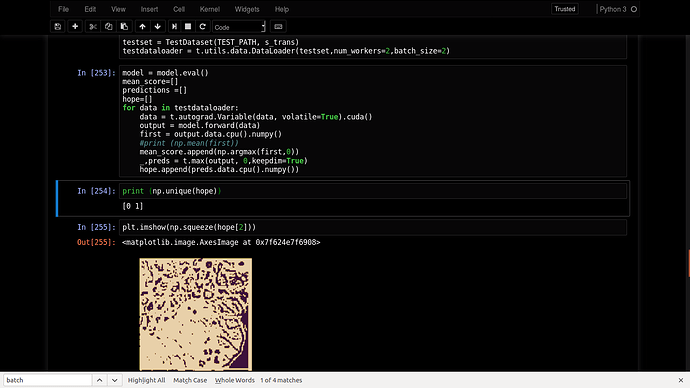The printed out the data.size it comes out to be [1,3,128,128],
I printed the training input(x_train) ,that too comes out to be [1,3,128,128]
The model def is
class double_conv(nn.Module):
'''(conv => BN => ReLU) * 2'''
def __init__(self, in_ch, out_ch):
super(double_conv, self).__init__()
self.conv = nn.Sequential(
nn.Conv2d(in_ch, out_ch, 3, padding=1),
nn.BatchNorm2d(out_ch),
nn.ReLU(inplace=True),
nn.Conv2d(out_ch, out_ch, 3, padding=1),
nn.BatchNorm2d(out_ch),
nn.ReLU(inplace=True)
)
def forward(self, x):
x = self.conv(x)
return x
class inconv(nn.Module):
def __init__(self, in_ch, out_ch):
super(inconv, self).__init__()
self.conv = double_conv(in_ch, out_ch)
def forward(self, x):
x = self.conv(x)
return x
class down(nn.Module):
def __init__(self, in_ch, out_ch):
super(down, self).__init__()
self.mpconv = nn.Sequential(
nn.MaxPool2d(2),
double_conv(in_ch, out_ch)
)
def forward(self, x):
x = self.mpconv(x)
return x
class up(nn.Module):
def __init__(self, in_ch, out_ch, bilinear=True):
super(up, self).__init__()
if bilinear:
self.up = nn.Upsample(scale_factor=2)
else:
self.up = nn.ConvTranspose2d(in_ch, out_ch, 2, stride=2)
self.conv = double_conv(in_ch, out_ch)
def forward(self, x1, x2):
x1 = self.up(x1)
diffX = x1.size()[2] - x2.size()[2]
diffY = x1.size()[3] - x2.size()[3]
x2 = F.pad(x2, (diffX // 2, int(diffX / 2),
diffY // 2, int(diffY / 2)))
x = t.cat([x2, x1], dim=1)
x = self.conv(x)
return x
class outconv(nn.Module):
def __init__(self, in_ch, out_ch):
super(outconv, self).__init__()
self.conv = nn.Conv2d(in_ch, out_ch, 1)
def forward(self, x):
x = self.conv(x)
return x
class UNet(nn.Module):
def __init__(self, n_channels, n_classes):
super(UNet, self).__init__()
self.inc = inconv(n_channels, 64)
self.down1 = down(64, 128)
self.down2 = down(128, 256)
self.down3 = down(256, 512)
self.down4 = down(512, 512)
self.up1 = up(1024, 256)
self.up2 = up(512, 128)
self.up3 = up(256, 64)
self.up4 = up(128, 64)
self.outc = outconv(64, n_classes)
def forward(self, x):
x1 = self.inc(x)
x2 = self.down1(x1)
x3 = self.down2(x2)
x4 = self.down3(x3)
x5 = self.down4(x4)
x = self.up1(x5, x4)
x = self.up2(x, x3)
x = self.up3(x, x2)
x = self.up4(x, x1)
x = self.outc(x)
x = t.nn.functional.sigmoid(x)
#x = t.nn.functional.softmax(x)
return x
def soft_dice_loss(inputs, targets):
num = targets.size(0)
m1 = inputs.view(num,-1)
m2 = targets.view(num,-1)
intersection = (m1 * m2)
score = 2. * (intersection.sum(1)+1) / (m1.sum(1) + m2.sum(1)+1)
score = 1 - score.sum()/num
return score
model = UNet(3,1).cuda()
optimizer = t.optim.Adam(model.parameters(),lr = 1e-3)
#configure("runs/run-1", flush_secs=2)
for epoch in range(1):
for x_train, y_train in tqdm(dataloader):
x_train = t.autograd.Variable(x_train).cuda()
y_train = t.autograd.Variable(y_train).cuda()
optimizer.zero_grad()
o = model.forward(x_train)
loss = soft_dice_loss(o, y_train)
loss.backward()
optimizer.step()
log_value('TrainLoss', loss, epoch)
print(o.size())
the testing part is
model = model.eval()
mean_score=[]
predictions =[]
hope=[]
for data in testdataloader:
data = t.autograd.Variable(data, volatile=True).cuda()
output = model(data)
first = output.data.cpu().numpy()
#print (np.mean(first))
mean_score.append(np.argmax(first,0))
_,preds = t.max(output, 0,keepdim=True)
hope.append(preds.data.cpu().numpy())
Let me know if you have any suggestions,Thanks


